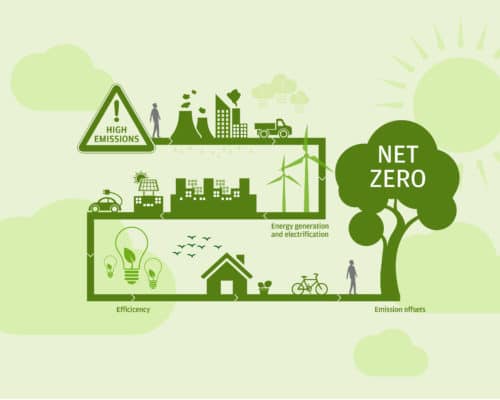G7 Ministerial Meetings 2024 – Outcomes
Photo: Shutterstock / ssi77
15 May 2024 – by Viktor Tachev
The 2024 G7 ministerial meetings on climate, energy and the environment concluded with the most ambitious target in history: ending unabated coal power use by the early 2030s. While economics and market realities can significantly accelerate the process, the group also left the door open for countries to stretch that deadline based on their individual circumstances. Furthermore, the G7 failed to seal the fate of gas and come up with more ambitious renewable energy deployment and energy transition financing pledges. Yet, the progress is a good first step in a crucial year, with elections in leading economies and the G20 and COP29 summits coming up.
The G7 Agrees to End Unabated Coal Power Use by 2035
After two days of active discussions in Turin, Italy, the energy ministerial meetings of G7 countries concluded on April 30th with a joint communique, agreeing to end unabated coal power plant use by 2035 at the latest. The agreement calls for phasing out unabated coal by the 2030s in advanced economies and by 2040 in all the other regions. Furthermore, it urges countries to stop building new unabated coal power capacity.
Unabated means coal power plants without carbon capture, where the CO2 is released directly into the atmosphere.
With the pledge, the G7 demonstrated its commitment to start curbing the rise in emissions. The agreement will be presented to G7 leaders to sign off at the summit in June.
While G7 nations have struggled for years to find common ground regarding a coal phaseout, the agreement reflects the increasing momentum against its use within the group. More importantly, it is making a huge step towards the emissions reduction timeline that the IPCC considers necessary to keep the 1.5°C target alive: 43% by 2030, 60% by 2035 and net zero by 2050.
What Else Did the G7 Energy Ministers Agree On?
The final communique also recognises that a successful energy transition requires a joint approach to achieving climate neutrality and strengthening energy security.
The ministers agreed to increase and expand the renewable energy technology mix, including clean power sources, energy efficiency, hydrogen, carbon management, storage, nuclear energy and fusion.
Furthermore, they committed to implementing the global goals to double energy efficiency rates to 4% and triple clean energy capacity to 11 TW by 2030. To ease the global journey towards those goals, the G7 also agreed to increase global energy storage in the power sector sixfold to 1,500 GW in 2030.
Regarding energy financing, the G7 members recognised the need to unlock trillions in climate finance. They reaffirmed their commitment to mobilise USD 100 billion annually until 2025, acknowledging the importance of going beyond the goal. They also pledged to scale up public and private financing, recognising the role of developing countries in the energy transition.
Energy ministers also acknowledged the need to peak emissions and develop measures to cut fossil fuel demand and subsidies, although without making concrete pledges.
The Coal Phaseout Pledge Comes With a Big Asterisk
The agreement doesn’t come without its caveats. The main one is that it gives leeway to countries “heavily reliant on coal”. As per the agreement, these countries might not stick with the 2035 deadline if they propose to pursue a timeline consistent with maintaining the course of 1.5°C. Currently, the most coal-dependent economies in the G7 are Germany and Japan. On a broader scale, two of the three biggest polluters, China and India, plan to continue adding new coal capacity.
Furthermore, according to a briefing by Japan’s Ministry of Economy, Trade and Industry (METI), the term “unabated” remains subject to interpretation by each country. METI, for example, considers highly efficient coal and ammonia co-firing an abated technology.
Another loophole in the final text enables the extended use of coal power plants with carbon capture technology.
While the media was quick to brand the agreement a historical success, the two caveats leave the door open for extended coal power use despite warnings that around 6% of the global coal fleet should be shut down annually in the years up to 2040. By that time, all capacity should be phased out or equipped with CCS.
The G7: A Story of Leaders and an Outlier
In recent years, G7 countries have made substantial, although still insufficient, progress towards coal phaseout through actions and policies.
The US Environmental Protection Agency now requires coal-fired power plants to either capture nearly all of their climate pollution or shut down before 2040. Furthermore, coal consumption in the country is now progressively and substantially decreasing.
According to Ember, the UK leads the pace in coal use reduction, with a 93% drop between 2015 and 2022, followed by France. Furthermore, both countries plan to close their last coal-fired power plants this year.
Coal comprises just 6% of Italy and Canada’s energy mixes. The former plans to end its use in 2025, and the latter to follow suit by 2030. Germany’s target for ending coal use is 2038, but it hopes to do so much earlier, by the early 2030s.
However, coal still comprises 32% of Japan’s electricity mix. Ember identifies Japan as “the clear outlier”, with only a 6% decline since 2015. Recently, it has even demonstrated signs of increased coal use. For comparison, the rest of the G7 have been reducing their consumption.
Japan remains the only G7 country without a domestic coal phaseout commitment. According to conservative estimates, the country’s current energy plan will ensure that coal still accounts for about 19% of the energy generation in 2030. Japan also remains a leading proponent of LNG and a range of questionable fossil fuel-based technologies, with substantial domestic and regional expansion plans.
Japan has established itself as the odd one out at the G7 table regarding climate policies, receiving substantial criticism from its peers. At past meetings, the country has been blocking progress on the issue and opposing other members’ ambitions to avoid language favourable to fossil fuel use and exploration.
Where the G7 Could Have Done Better
Despite G7 members making the most ambitious pledges to date and branding their decisions a “historic success,” the commitments still fall short of what is needed to deliver on the Paris Agreement. Climate analysts and environmental groups note the commitment is “too little, too late” and fails to acknowledge the historical responsibility of the biggest polluters on the lives of climate-vulnerable communities in developing regions. Furthermore, the 2035 target year the G7 countries set to phase out coal isn’t enough to keep the world within “safe” levels of heating.
More Ambitious Emissions Reduction and Gas Phaseout Necessary
Pledging to end unabated coal power use by 2035 doesn’t align with the IEA’s Net Zero Emissions by 2050 Scenario (NZE). According to the NZE Scenario, the global power sector should be completely decarbonised in advanced economies by 2035. Furthermore, an analysis by the Kleinman Center for Energy Policy at the University of Pennsylvania, notes that the current agreement fails to acknowledge that the 10-year time span will allow for a massive deployment of new coal power plants. Considering that their average lifespan is around 60 years, it would lock countries, mainly highly industrialised ones such as China, India, and Indonesia, into years of pollution.
Climate Analytics estimates that the G7 is currently on track for between 19% and 33% in emissions reduction by 2030. This is way below the group’s current 42% reduction target. To do their part to limit warming to 1.5°C, the analysts call for G7 members to aim for a 58% emissions reduction target by 2030. Currently, no G7 member is on track to meet its existing targets.
“These economies, who make up 38% of the world’s GDP, are not pulling their weight: they have both the technology and the finance to up their game. Against the backdrop of unprecedented climate extremes exacerbated by the use of fossil fuels, taking ambitious action to decarbonise and setting a deadline to move away from fossil fuels should be the bare minimum,” says Neil Grant, the lead author of the Climate Analytics analysis.
The report also urges G7 nations to commit to phasing out domestic coal and fossil gas power generation by 2030 and 2035, respectively. While most G7 governments actively limit coal’s role in their energy systems, natural gas remains a central focus, with mass capacity buildup evident in their plans. In the final communique, natural gas is referenced only in relation to Russian imports and energy security. However, a plan for gas phaseout is missing.
“The problem is that whilst coal power has already been falling, gas power has not. Coal might be the dirtiest, but all fossil fuels should ultimately be phased out,” warns Dave Jones, program director of Ember’s Global Insights.
Scaling Up Financing
The G7 reiterated providing the USD 100 billion promised in 2009, but only delivered two years after the deadline. However, according to experts, the target is weak and insufficient to cover even the adaptation needs of developing countries. Currently, they stand at USD 160-340 billion by 2030 and USD 315-565 billion by 2050.
Others warn that the needs of developing countries, excluding China, to successfully deliver the Paris Agreement are around USD 1 trillion in 2025 and USD 2.4 trillion by 2030. In that sense, the G7 members must step up and scale up financing in the coming months if the energy transition is to succeed. This month’s G7 finance ministers’ meeting provides a prime opportunity to ensure their actions fully align with their promises and demonstrate increased ambition.
Increased Clean Energy Deployment
The G7 failed to increase their collective clean energy deployment target. This is a missed opportunity, considering that Ember finds that the group only targets a doubling.
To accelerate progress, Ember urges the G7 to commit to a goal of tripling its renewable capacity from 0.9 TW in 2022 to 2.7 TW in 2030. Furthermore, it stresses the importance of G7 leaders to help unlock clean energy growth across emerging countries by designing and presenting an action plan at COP29.
Disincentivising Fossil Fuel Additions
While the G7 recognised the importance of phasing out international support and subsidies for fossil fuels, they didn’t pledge a concrete target. This is imperative, considering that in 2022, according to IRENA, G20 members alone provided a record USD 1.4 trillion in public funds to support fossil fuels. This is more than the annual clean energy investment needed to achieve the target of tripling renewable capacity by 2030.
Towards the 2024 Elections, G20 and COP29 Summits
The G7 should lead global climate policy. Its decisions can influence the outcomes of the wider G20 and the COP meetings and the fragile global climate progress and energy agenda in a year when leading polluters are having elections.
The recent G7 agreement is a step in the right direction. However, making promises is one thing, honouring those promises is another. Whether the energy transition will succeed depends on how G7 countries will turn their pledges into action.
The G20 and COP29 summits and the upcoming NDC updates round provide the perfect opportunities to stride further.
by Viktor Tachev
Viktor has years of experience in financial markets and energy finance, working as a marketing consultant and content creator for leading institutions, NGOs, and tech startups. He is a regular contributor to knowledge hubs and magazines, tackling the latest trends in sustainability and green energy.
Read more







